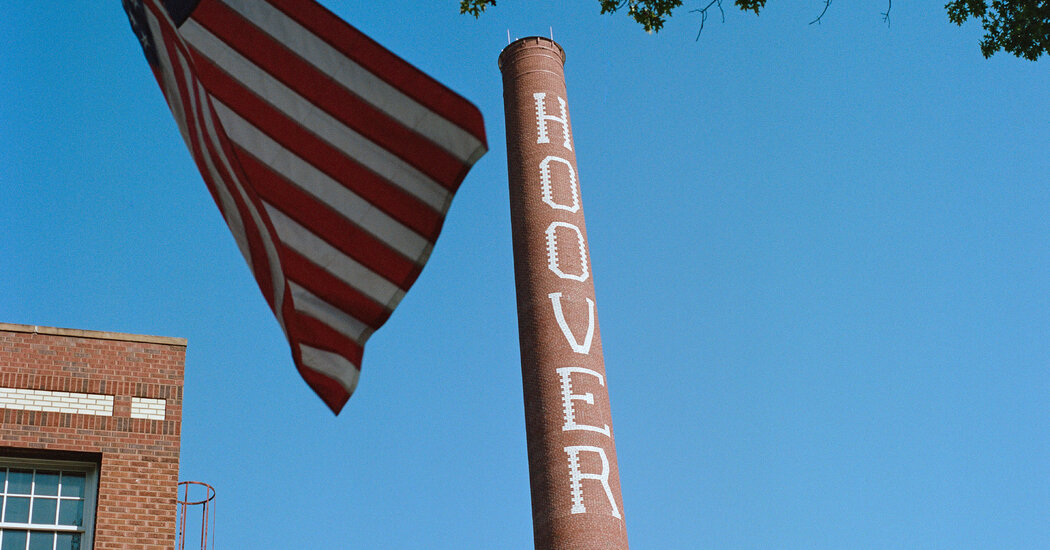Canton, Ohio, once called itself the City of Diversified Industries. That name, locals acknowledge, does not exactly roll off the tongue. But it reflected an important part of the town’s identity as a manufacturing hub, with businesses like the appliance company Hoover based there.
Today, Canton is not doing as well. The number of manufacturing jobs has fallen 45 percent since the late 1990s, as factories have shuttered or moved to Mexico, China and elsewhere. People have joined the exodus; the city’s population is now 71,000, down from 110,000 in 1970. The poverty rate — 25 percent — is nearly double the state average.
Canton represents the kind of struggling manufacturing town that once churned out American products. Both major party presidential candidates have pledged to revitalize this kind of place by bringing back manufacturing to the United States.
Canton represents the kind of struggling manufacturing town that once churned out American products.
The Canton Palace Theater.
To make foreign products less competitive against American goods, former President Donald J. Trump has promised to impose a 10 percent to 20 percent tariff — effectively a sales tax — on all imports. Vice President Kamala Harris has proposed new government subsidies to build factories in the United States.
In some ways, the campaigns promise to revive the conditions that made Canton a manufacturing hub in the first place. In the early 20th century, the United States had higher tariffs on imports, which helped keep American goods cheaper than foreign products. At the same time, a local group of businessmen, known as the Canton Board of Trade, used what were effectively subsidies — money and free land — to lure manufacturers into the area.
Still, many economists are skeptical. They argue that the candidates’ proposals aren’t enough to reverse the trends — globalization, free trade agreements, automation and other technological changes — that caused manufacturing jobs to leave America in the first place.
Consider Mr. Trump’s tariffs plan. The goal of tariffs is to drive up the price of cheap foreign products, so more expensive American goods can compete. But Mr. Trump’s plan would raise prices on all imports, including components used by manufacturers to make American goods. As manufacturers pay more for those parts, the possible benefits of a tariff could wash away.
Across-the-board tariffs “cause all sorts of indirect costs and damage for manufacturers,” said Alec Stapp, an economist and co-founder of the Institute for Progress, a think tank. He cited research that found tariffs from Mr. Trump’s presidency had hurt more than helped American manufacturers.
Given that outcome, the tariffs might simply raise prices — as foreign companies pass the cost of higher taxes down to consumers — without leading to more American manufacturing jobs. That would be especially difficult for a place like Canton, where people are relatively poorer and higher prices eat up a greater portion of lower incomes.
Ms. Harris’s proposal of new investments and tax credits might have more success bringing back some jobs. Federal handouts have kick-started renewable energy projects nationwide. And President Biden’s subsidies have led to a boom in new factory construction, including a large microchip plant in Phoenix.
But subsidies are usually upfront and temporary, limiting their effect. Companies build new factories expecting to keep them open for years. They can’t do that if they know a crucial source of funding will eventually expire. That helps explain why, despite Mr. Biden’s subsidies, the number of manufacturing jobs nationwide remains 34 percent lower than it was in the late 1970s.
The question is whether the American economy has evolved past the days of making basic goods. As the country has become richer and more educated, its economic output has become more about innovation and new technologies, instead of mass-produced household items.
The American product of the future is artificial intelligence, not vacuum cleaners.
A vacant apartment building.
The Metallus steel plant.
In this economic reality, places like Canton have lost out as others, like Silicon Valley and Boston, have benefited from their tech industries. Politicians have long promised to help retrain workers to get into new industries, but those programs have historically failed to deliver.
Modern manufacturing jobs also often require a postsecondary education. Yet in Canton, residents are 36 percent less likely to have an associate degree or higher than all Ohioans.
“For many people, getting a factory job right out of high school was the norm, and it provided a very good living with the security of a pension in retirement,” said Kimberly Kenney, a local historian and executive director of the McKinley Presidential Library and Museum.
Canton, then, faces a fundamental mismatch between the work force that it has and the work force that the country’s new economy needs. (Canton officials declined to comment for this article.)
All of that makes it unlikely that Canton and other former manufacturing hubs can be revived by simply bringing back their old jobs. Local leaders have acknowledged as much, starting an organization that seeks to revitalize Canton by boosting local higher education and expanding the town’s economy into fracking and tourism.
It’s possible that the glory days of the City of Diversified Industries will never come back, despite politicians’ promises.
Checkout latest world news below links :
World News || Latest News || U.S. News
The post Can Donald Trump or Kamala Harris Bring Back Manufacturing Jobs? appeared first on WorldNewsEra.

